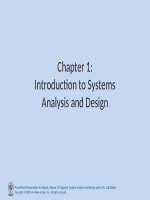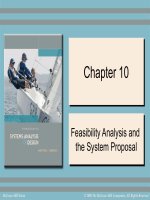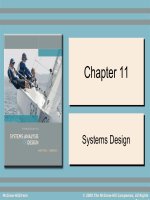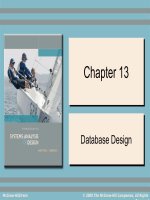Lecture Introduction to systems analysis and design Chapter 9 Whitten, Bentley
Bạn đang xem bản rút gọn của tài liệu. Xem và tải ngay bản đầy đủ của tài liệu tại đây (2 MB, 47 trang )
Chapter
Chapter 99
Object-Oriented
Object-Oriented
Analysis
Analysis and
and Modeling
Modeling
Using
Using the
the UML
UML
McGraw-Hill/Irwin
© 2008 The McGraw-Hill Companies, All Rights Reserved
9-2
Objectives
• Define object modeling and explain its benefits.
• Recognize and understand the basic concepts
and constructs of object modeling.
• Define the UML and its various types of
diagrams.
• Evolve a business requirements use-case
model into a system analysis use-case model.
• Construct an activity diagram.
• Discover objects and classes, and their
relationships.
• Construct a class diagram.
9-3
Introduction to Object Modeling
Object-oriented analysis (OOA) – an
approach used to
1. study existing objects to see if they can be reused
or adapted for new uses
2. define new or modified objects that will be
combined with existing objects into a useful
business computing application
Object modeling – a technique for identifying
objects within the systems environment and
the relationships between those objects.
9-4
Introduction to the UML
Unified Modeling Language (UML) – a set
of modeling conventions that is used to
specify or describe a software system in
terms of objects.
• The UML does not prescribe a method for developing
systems—only a notation that is now widely accepted
as a standard for object modeling.
9-5
Objects & Attributes
Object – something that is or is capable of
being seen, touched, or otherwise sensed,
and about which users store data and
associate behavior.
–
–
–
–
Person, place, thing, or event
Employee, customer, instructor, student
Warehouse, office, building, room
Product, vehicle, computer, videotape
Attribute – the data that represent
characteristics of interest about an object.
9-6
Objects & Object Instances
Object instance – each specific person, place,
thing, or event, as well as the values for the
attributes of that object.
9-7
Behavior & Encapsulation
Behavior – the set of things that the
object can do that correspond to
functions that act on the object’s data (or
attributes).
– In object-oriented circles, an object’s
behavior is commonly referred to as a
method, operation, or service.
Encapsulation – the packaging of
several items together into one unit.
9-8
Object Classes
Object Class – a set of objects that
share common attributes and
behavior. Sometimes referred to as a
class.
9-9
Representing Object Classes
in the UML
9-10
Inheritance
Inheritance – the concept wherein methods
and/or attributes defined in an object class can
be inherited or reused by another object class.
9-11
Inheritance (cont.)
9-12
Generalization/Specialization,
Supertype, and Subtype
Generalization/specialization – technique wherein
attributes and behaviors common to several types of
object classes are grouped (or abstracted) into their own
class, called a supertype.
Supertype – an entity that contains attributes and
behaviors that are common to one or more class
subtypes. Also referred to as abstract or parent class.
Subtype – an object class that inherits attributes and
behaviors from a supertype class and may contain other
attributes and behaviors unique to it. Also referred to as a
child class and, if it exists at the lowest level of the
inheritance hierarchy, as concrete class.
9-13
UML Representation of
Generalization/Specialization
9-14
Object/Class Relationships
Object/class relationship – a natural
business association that exists between
one or more objects and classes.
9-15
UML Multiplicity Notations
Multiplicity – the
minimum and
maximum
number of
occurrences of
one object/class
for a single
occurrence of the
related
object/class.
9-16
Aggregation
Aggregation – a
relationship in which one
larger “whole” class contains
one or more smaller “parts”
classes. Conversely, a
smaller “part” class is part of
a “whole” larger class
– In UML 2.0 the notation for
aggregation has been
dropped
9-17
Composition
Composition –
an aggregation
relationship in
which the
“whole” is
responsible for
the creation and
destruction of its
“parts.” If the
“whole” were to
die, the “part”
would die with it.
9-18
Messages
Message – communication that occurs when
one object invokes another object’s method
(behavior) to request information or some action
9-19
Polymorphism
Polymorphism – the
concept that different
objects can respond to
the same message in
different ways.
Override – a
technique whereby a
subclass (subtype)
uses an attribute or
behavior of its own
instead of an attribute
or behavior inherited
from the class
(supertype).
9-20
UML 2.0 Diagrams
Diagram
Use Case
Description
Depicts interactions between the system and external systems
and users. In other words it graphically describes who will use
the system and in what ways the user expects to interact with
the system. The use-case narrative is used in addition to
textually describe the sequence of steps of each interaction.
Activity
Depicts sequential flow of activities of a use case or business
process. It can also be used to model logic with the system.
Depicts the system's object structure. It shows object classes
that the system is composed of as well as the relationships
between those object classes.
Similar to a class diagram, but instead of depicting object
classes, it models actual object instances with current attribute
values. The object diagram provides the developer with a
"snapshot" of the system's object at one point in time.
Class
Object
State Machine
Composite Structure
Models how events can change the state of an object over its
lifetime, showing both the various states that an object can
assume and the transitions between those states.
Decomposes internal structure of class, component, or use case.
9-21
UML 2.0 Diagrams (cont.)
Diagram
Sequence
Communication
Interaction Overview
Timing
Component
Deployment
Package
Description
Graphically depicts how objects interact with each other via
messages in the execution of a use case or operation. It
illustrates how messages are sent and received between objects
and in what sequence.
(Collaboration diagram in UML 1.X) Depicts interaction of objects
via messages. While a sequence diagram focuses on the timing
or sequence of messages, a communication diagram focuses on
the structural organization of objects in a network format.
Combines features of sequence and activity diagrams to show
how objects interact within each activity of a use case.
Another interaction diagram that focuses on timing constraints in
the changing state of a single object or group of objects.
Especially useful when designing embedded software for
devices.
Depicts the organization of programming code divided into
components and how the components interact.
Depicts the configuration of software components within the
physical architecture of the system's hardware "nodes."
Depicts how classes or other UML constructs are organized into
packages (corresponding to Java packages or C++ and .NET
9-22
The Process of Object Modeling
1. Modeling the functions of the system.
2. Finding and identifying the business
objects.
3. Organizing the objects and identifying
their relationships.
9-23
Construction the Analysis
Use-Case Model
System analysis use case – a use case that
documents the interaction between the system
user and the system. It is highly detailed in
describing what is required but is free of most
implementation details and constraints.
1. Identify, define, and document new actors.
2. Identify, define, and document new use cases.
3. Identify any reuse possibilities.
4. Refine the use-case model diagram (if necessary).
5. Document system analysis use-case narratives.
9-24
Revised System
Use-Case Model Diagram
9-25
Use-Case Narrative









